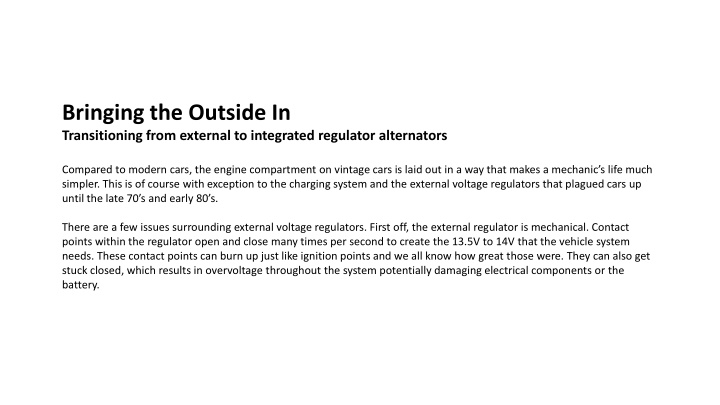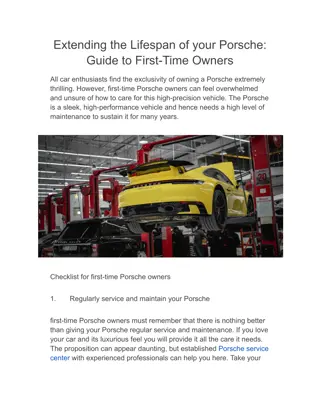
Upgrading Vintage Cars with Integrated Regulator Alternators
Learn about the transition from external to integrated regulator alternators in vintage cars, the benefits of integrated regulators, common applications like Porsche 911/T, installation tips, and key changes needed for upgrading alternators on vehicles built prior to 1982.
Download Presentation

Please find below an Image/Link to download the presentation.
The content on the website is provided AS IS for your information and personal use only. It may not be sold, licensed, or shared on other websites without obtaining consent from the author. If you encounter any issues during the download, it is possible that the publisher has removed the file from their server.
You are allowed to download the files provided on this website for personal or commercial use, subject to the condition that they are used lawfully. All files are the property of their respective owners.
The content on the website is provided AS IS for your information and personal use only. It may not be sold, licensed, or shared on other websites without obtaining consent from the author.
E N D
Presentation Transcript
Bringing the Outside In Transitioning from external to integrated regulator alternators Compared to modern cars, the engine compartment on vintage cars is laid out in a way that makes a mechanic s life much simpler. This is of course with exception to the charging system and the external voltage regulators that plagued cars up until the late 70 s and early 80 s. There are a few issues surrounding external voltage regulators. First off, the external regulator is mechanical. Contact points within the regulator open and close many times per second to create the 13.5V to 14V that the vehicle system needs. These contact points can burn up just like ignition points and we all know how great those were. They can also get stuck closed, which results in overvoltage throughout the system potentially damaging electrical components or the battery.
Bringing the Outside In Transitioning from external to integrated regulator alternators These and many other reasons are why integrated regulators were designed. By operating internal to the alternator, they can be directly connected to the key components offering better performance and reliability. This makes an internally regulated alternator a common upgrade for those looking to improve the performance of their vehicles. This does however cause some confusion as to how to properly wire up the vehicle which is why companies like Valeo have provided cheat sheets to assist in this process as well as technical support to handle any unique situations. In Figure A you can see a list of some of the most common applications that we ve come across in relation to this topic as well as the diagram showing the proper way to wire it up. Figure A
Porsche Integrated Regulator Alternators FAQs, Installation and Wiring Tips Some of the most common applications covered in this topic are 1974- 1983 Porsche 911/T. While these applications may be well over 30 years old, the Porsche restoration market is incredibly active, imposing a great demand for aftermarket parts and services. Understanding this demand and the need for improvements over some of the antiquated technology, some companies offer updated versions of these products. The alternators being sold in the aftermarket by Valeo are using an integrated regulator in place of the original external regulators of the 70 s and 80 s. This poses certain installation changes that can trip up even seasoned DIYers causing them to seek guidance from the manufacture. This new design relocates the regulator onto the back of the alternator and can be replaced separately from the alternator later down the line if necessary. Threads on the alternator shaft have also changed from the original M16 x 1 to M17 x 1.5. Figure B Figure B Valeo 432776
The hub extension, or air guide, has also been modified to provide an opening for the regulator. The battery charge indicator lamp is changed from the original 2 watts to 4 watts and the DF wire will be removed from the engine wiring harness. Note: These changes took effect with the 1982 model year production. On some early 1982 models, a ground wire was not installed between the crankcase and alternator. This issue of inadequate grounding can cause a parasitic drain on the battery as well as radio interference. If either of these problems develop or the alternator needs to be removed for repairs, make sure to install the missing ground wire to establish the proper circuit. Also note that the following parts will be required when installing the alternator on cars built prior to 1982. Alternator (Valeo 432776) 911 603 120 04 Air Duct Air Duct 911 106 033 05 Cover 911 603 428 01 Connector Connector 111 971 511 Resistor (91ohms, 5W) 911 641 981 00 Cover
Installation Guide - Disconnect the battery - Remove the old alternator - Remove the hub extension - Cut off the DF wire at the branch of the wiring harness - Remove the alternator regulator - Fasten the multi-pin plug of the removed regulator on the wiring harness - Install the new alternator in the blower housing - Push new hub extension onto the wiring harness and connect the alternator as seen in Figure C B+ = Red Wire D- = Brown wires (ground 2 required) 61 = Blue wire - Mount the hub extension on the alternator and install the blower housing - Tighten the drive belt as specified - If applicable, install the air conditioner compressor with the drive belt - Reconnect the battery 61 Blue wire B+ Red wire D- Brown wires Figure C
Note: If the battery charge indicator lap does not go out after starting the engine, the exciter current is too low because of the 2 watt lamp. In this case, install the resistor (911 641 981 00, 91ohms, 5W) parallel to the battery charge indicator lamp. To install the resistor, remove the instrument cluster and take out the battery charge indicator lamp socket. Install both piggyback connectors (111 971 511) on the lamp socket and solder the resistor on the outer flat male terminals. Reconnect the lamp socket and install the instrument cluster. Recheck the battery charge indicator lamp operation and tightness of the belt after briefly running the engine. Note: 1982 model cars have a 4 watt indicator lamp, however the larger socket cannot be inserted in the instrument cluster of older models.






















